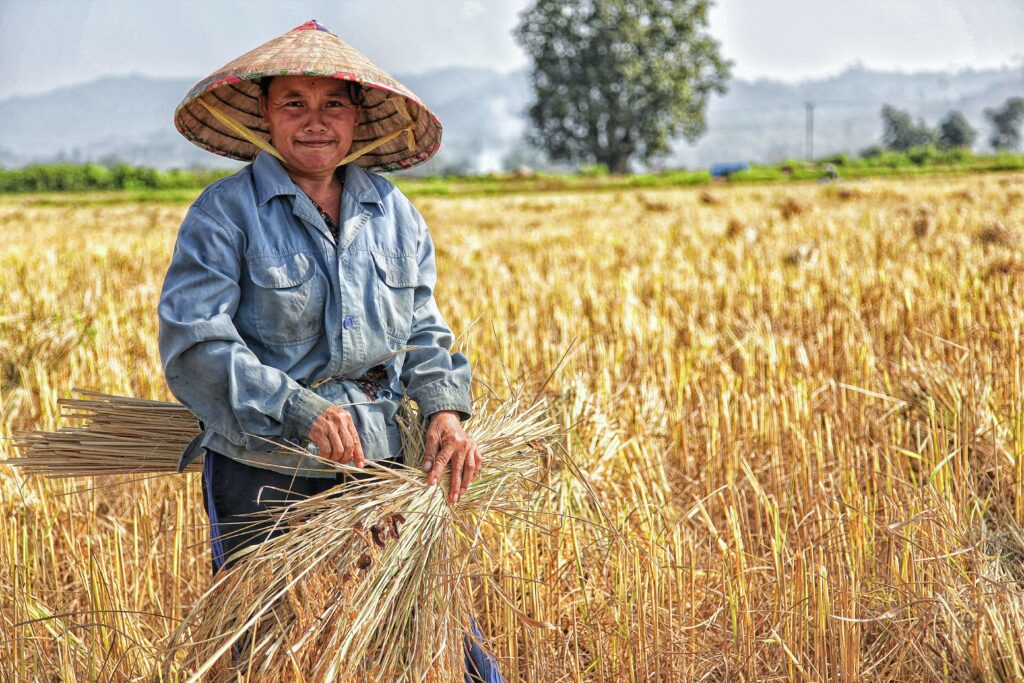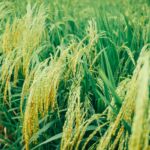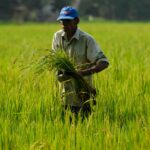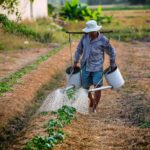There are numerous initiatives that support smallholder farmers from various organizations all over the world and for decades. However, farmers are rarely involved in the design of initiatives and projects which objective is to make their life better. Including the smallholder farmers perspective in agricultural project is challenging for a variety of reasons. Whatever the difficulties their involvement is critical to mitigate the environmental and human rights challengs of agricultural commodities supply chains. Here are 10 principles ensuring success we have learned across our programs and experiences at Ksapa.
Smallholders Are the Decisive Link in the Supply Chain Risk Reduction Chain When it Comes to Mitigating Agricultural Commodity Environmental and Human Rights Challenges
In our work and experience working with buyers, and engaging extensively with supply chain stakeholders around the globe and across a variety of industries, there are 8 reasons why smallholders end up being always the decisive link to actually mitigate environmental and human right risks pertaining to agricultural commodity sourcing activities.
- Environmental Conservation: Smallholders often cultivate agricultural land on a smaller scale and have a closer connection to their local ecosystems. Their involvement can promote sustainable farming practices, such as agroforestry, organic farming, and biodiversity conservation. Smallholders are more likely to implement environmentally friendly techniques that reduce chemical inputs, prevent soil erosion, preserve water resources, and protect natural habitats.
- Landscape Restoration and Conservation: Smallholders often operate within landscapes that encompass diverse ecosystems, including forests, wetlands, and grasslands. Their participation is crucial for landscape restoration initiatives aimed at conserving biodiversity, restoring degraded lands, and mitigating climate change. Smallholders can contribute to reforestation efforts, habitat conservation, and the establishment of sustainable land management practices.
- Climate Change Mitigation and Adaptation: Smallholders, especially those in vulnerable regions, are disproportionately affected by climate change. Engaging smallholders in agricultural commodity supply chains can help build their resilience and support climate change mitigation efforts. Practices like regenerative, conservation or climate-smart agriculture can be implemented by smallholders to reduce greenhouse gas emissions, enhance carbon sequestration, and adapt to changing climate conditions.
- Poverty Alleviation and Rural Development: Smallholders often reside in rural and marginalized communities and are reliant on agriculture for their livelihoods. Involving smallholders in agricultural commodity supply chains can improve their incomes, create employment opportunities, and contribute to poverty alleviation and rural development. By empowering smallholders, their communities can experience improved standards of living, enhanced access to education and healthcare, and reduced vulnerability to economic shocks.
- Social Inclusion and Human Rights: Smallholders, including indigenous peoples and rural communities, are often marginalized and face challenges in securing their land rights, accessing markets, and participating in decision-making processes. Engaging smallholders in supply chains through a formal recognition of their role as producers would definitely help promote their social inclusion, protect their human rights, and ensure fair and equitable benefits from agricultural activities.
- Diverse Agricultural Practices and Food Security: Smallholders contribute significantly to crop diversity, preserving traditional and indigenous knowledge systems, and maintaining a wide range of hardy varieties. Their involvement in supply chains helps safeguard agricultural biodiversity, which is crucial for long-term food security, resilience against pests and diseases, and the adaptation of crops to changing environmental conditions.
- Market Access and Value Chain Integration: By involving smallholders in agricultural commodity supply chains, they gain access to formal markets, fair prices, and value-added opportunities. This integration can help improve their economic prospects and reduce their dependency on subsistence farming. Market access can also incentivize smallholders to adopt sustainable practices, improve quality and comply with environmental and social standards set by corporate buyers and certification schemes.
- Food safety and quality: it is recognized that many traders and intermediaries who have a direct access to smallholder farmers can cheat on farmers when buying products at a low price and sell it at a higher price. Usually between these 2 transactions traders can alter the product quality and quantity by adding water or foreign matters to increase its weigh. This alteration can have a significant impact on the quality, taste or integrity of the product especially when transportation/packing/storage conditions are not good. That’s why involving farmers and enabling them to sell directly their products to supply chain operators can often help to improve quality.
In summary, involving smallholders in agricultural commodity supply chains is essential to mitigate environmental challenges, promote sustainable practices, protect human rights, alleviate poverty, enhance resilience, and foster inclusive rural development. Their participation contributes to the long-term sustainability and equitable transformation of agricultural systems. However this process appears long and very challenging when it comes to approach and gained the trust of smallholder farmers.
What Are The Challenges Involving Smallholders in Agricultural Commodity Supply Chains?
The involvement of farmers is therefore undeniably decisive. But this is far from being a general practice in programs run by private and public players. The reason is simple: it’s complicated. But it is by working at this level that the greatest impact can be made. So we need to understand why it’s complicated, in order to identify the levers available to try and remove these obstacles.
1. Isolation and Remoteness
Here’s what we call isolation and remoteness framing why the involvement of farmers is doubtless all too often challenging.
- Limited Access to Resources and Inputs: Smallholders often face challenges in accessing essential resources and inputs such as land, credit, seeds, fertilizers, and equipment. Limited access hampers their ability to adopt sustainable farming practices, invest in productivity-enhancing technologies, and meet quality standards required by supply chains.
- Lack of Technical Knowledge and Training: Many smallholders lack access to adequate training, technical knowledge, and information on sustainable agriculture practices, environmental conservation, and human rights. This knowledge gap can hinder their ability to adopt sustainable practices and meet the requirements of corporate buyers or certification programs.
- Weak Market Linkages: Smallholders often face difficulties in accessing formal markets, establishing reliable market linkages, and negotiating fair prices for their produce. They may lack the necessary infrastructure, market information, bargaining power, and market intelligence to engage effectively with supply chains.
- Limited Financial Resources: Smallholders often have limited financial resources and struggle to access credit, making it challenging to invest in sustainable farming technologies, inputs, and infrastructure. Insufficient capital restricts their ability to scale up production, improve their productivity, and participate fully in supply chains.
2. Vulnerability and Precarity
We also hereby provide an overview of the multifaceted dimensions of vulnerability and precarity framing why the involvement of smallholders is doubtless all too often challenging as well.
- Market Infrastructure: Limited access to infrastructure, including roads, storage facilities, processing units, and transportation networks, can hinder smallholders’ ability to connect with supply chains and access markets in a timely and cost-effective manner. They are thus comply to sell to traders who come at their arm gate without any chance to negotiate the price. Infrastructure gaps may result in post-harvest losses, reduced product quality, and limited market opportunities.
- Land Tenure Insecurity: Smallholders frequently face land tenure insecurity, with unclear or informal land rights, leading to vulnerability and displacement. Insecure land tenure can hinder their long-term investments in sustainable practices and limit their ability to access credit and other support services.
- Capacity Constraints: Smallholders may lack the organizational capacity, cooperative structures, or business skills needed to effectively engage with supply chains. They may face challenges in meeting quality standards, adhering to certification requirements, and complying with traceability and transparency demands.
- Social and Gender Inequality: Smallholder communities, particularly women and marginalized groups, may face social and gender inequalities that limit their access to resources, decision-making power, and participation in supply chains. Addressing these inequalities is crucial to ensure inclusive and equitable involvement of smallholders.
- Policy and Institutional Challenges: Inadequate policy frameworks, weak institutions, and a lack of supportive infrastructure can hinder smallholder engagement in supply chains. Smallholders need an enabling environment that includes favorable policies, access to extension services, supportive governance structures, and effective institutions to facilitate their participation and address their specific needs.
Addressing these challenges requires a comprehensive approach involving stakeholders such as governments, civil society organizations, corporate buyers, and development agencies. Providing targeted support, including access to resources, knowledge transfer, financial services, and market linkages, can help overcome these challenges and empower smallholders to participate effectively in sustainable agricultural commodity supply chains.
10 Principles to Design and Deploy Successful Programs Involving Smallholders to Mitigating the Environmental and Human Rights Challenges of Agricultural Commodity Supply Chains
At Ksapa we have been designing and deploying successful programs involving smallholders to mitigate the environmental and human rights challenges of agricultural commodity supply chains. We know it requires careful planning and implementation. Here are some key steps and considerations we have learned across our experiences and programs:
Set-up Mechanism that Build Trust and Interest Among Farmers
Smallholders are risk adverse and involving smallholder communities starts by building trust, and foster interest among farmers for committing to taking part in programs. Here are 5 principles to apply in this regard, learned from our experiences and programs at Ksapa:
- Design a win-win approach including the farmer perspective straight from the design phase: Implementing practices that have a positive effect on environment and farmers livelihoods usually require specific trainings and additional work on the plot. Changing habits requires also a mental effort that is difficult to provide especially when you’re getting older. In that respect, sustainable agriculture practices such as zero tillage for instance require to spend more time on the plot and use more energy. As such, manual weeding is more difficult than using machine or herbicide. In addition, concepts the like “regenerative agriculture”, “climate smart agriculture” or “net zero” are mostly coming from corporate world in order to comply with international regulation frameworks. It doesn’t mean these concepts mean something concrete from the perspective of farmers. Farmers generally have low interest for such concepts. They need to understand what’s in it for them. They need to see how they can make be rewarded in the short term. Incentives (premium of certifications) may help, but that again needs to be confirmed getting feedback from farmers. One more reason why involving farmers from the design phase of projects remains so critical.
- Deploy Capacity Building: Provide training and capacity-building programs to smallholders to enhance their knowledge and skills in sustainable farming practices, environmental conservation, labor rights, and social empowerment. Offer technical assistance, extension services, and access to relevant information and best practices.
- Ensure Access to Resources: Support smallholders in accessing essential resources and inputs, such as land, credit, seeds, fertilizers, and equipment. Facilitate access to financial services, develop mechanisms for fair and affordable credit, and establish linkages with input suppliers.
- Provide Market Linkages: Facilitate market linkages for smallholders to ensure fair and direct access to markets. Strengthen their bargaining power, promote collective action, and support the establishment of cooperatives or producer groups. Foster relationships between smallholders and corporate buyers, including through direct sourcing arrangements or partnerships.
- Long-term Commitment: Ensure that the program has a long-term perspective and commitment to sustainability. Smallholders’ involvement should extend beyond short-term projects to enable lasting change, continuous improvement, and sustained benefits for smallholders and the environment.
2. Breaking Down Stereotypes
Top down approaches generally fail simply because reality on the ground is all too often just too different from concepts and clichés. Here are 5 principles derived from our experiences and programs we encourage to apply working very hard on breaking down stereotypes to align agendas across stakeholders along value chains.
- Understand the local context, including the social, economic, and environmental conditions, as well as the specific challenges faced by smallholders in the target area. Identify the key environmental and human rights issues prevalent in the agricultural supply chains and their root causes.
- Help farmers understand the market downstream their activities, and the price structure of what they are selling. It’s proven to be major to explain to farmers what their product will become once sold. From factory gate to end product, once farmers understand their role being the first mile of a long process ending to a final product, farmers definitely understand the challenges related to food quality and safety among others. That usually helps to make the connection between processing cost and purchasing price by the factory. That enable to explain how the price is calculated based of processing cost and world index. Through price transparency trust is improved between farmers and buyers.
- Ensure stakeholder engagement: Involve smallholders, local communities, government agencies, civil society organizations, and corporate buyers in the program design process. Foster dialogue and collaboration among stakeholders to ensure that the program addresses the specific needs and priorities of smallholders while aligning with the objectives of corporate buyers and sustainability standards.
- Build partnerships and collaboration: Collaborate with various stakeholders, including governments, NGOs, research institutions, and corporate buyers, to leverage expertise, resources, and networks. Engage in multi-stakeholder platforms and initiatives focused on sustainable agriculture and responsible supply chains.
- Facilitate knowledge sharing and scaling up: Document and share lessons learned from the program, both successes and challenges. Disseminate knowledge and best practices to other regions and stakeholders to encourage scaling up and replication of successful models.
By following these steps and considering the specific needs and challenges of smallholders, programs can effectively involve them in mitigating environmental and human rights challenges in agricultural commodity supply chains, leading to sustainable and inclusive development. Today, using digital tools designed to be deployed in rural areas where digital literacy might be as challenging as connectivity is a critical lever ensuring ongoing cost effective application of the 10 principles outlined in this section. Understanding what benefits smallholders can access using digital solutions is therefore useful to close the loop deploying programs ensuring effective inclusion of smallholders to maximize the positive environmental and human right impacts of agricultural commodity supply chain programs.
What Benefits for Smallholders to Access Digitalized Support From Their Cash Crop Buyers?
Our digital suite at Ksapa is designed and deployed to incorporate smallholders in digitalized transactions between buyers and farmers. After a training session performed in small groups, farmers will have a permanent access to our Sutti digital platform which provides a range of services connecting farmers to their local ecosystems:
- Market Information: Our Sutti digital platform can provide smallholders with real-time market information, including prices, demand trends, and market opportunities. This enables smallholders to make informed decisions regarding crop selection, timing of sales, and negotiation of fair prices. Access to market information reduces information asymmetry and empowers smallholders in their interactions with buyers.
- Market Access: Our Sutti digital platform can be plugged with selected e-commerce channels to connect smallholders directly with cash crop buyers to negotiate better prices for their produce, but also access selected equipment and products vetted to provide effective support improving pest & disease control, fertility and yield management among other agronomic priorities. By accessing larger markets, smallholders can expand their customer and supply base and reduce dependency on local buyers.
- Price Transparency: Our Sutti digital platform can facilitate price transparency by providing smallholders with real-time pricing information. Smallholders can compare prices offered by different buyers and make informed decisions on where to sell their crops.
- Advisory Services and Knowledge Sharing: Our Sutti digital platform can deliver advisory services, extension information, and training modules tailored to the specific needs of smallholders. These services provide guidance on sustainable farming practices, pest management, climate resilience, and crop diversification. Access to relevant information and knowledge empowers smallholders to make informed decisions, enhance their agricultural practices, and improve their yields.
- Capacity Building and Technical Support: Our Sutti digitalized support offers capacity building and technical assistance to smallholders, helping them improve their farming skills, adopt sustainable practices, and address challenges. This support can be delivered through online training modules, virtual consultations, and knowledge-sharing platforms, enabling scalability and wider reach. We generally combine with face to face interactions ensuring group discussions can happen, and referent leaders can be identified to strengthen significantly learning curve and adoption of better practices
- Data Collection and Analysis: Our digital platform collects and analyzes data related to smallholders’ farming practices, yields, and environmental impact. This data can be used to provide personalized recommendations, optimize resource utilization, and identify areas for improvement. Data-driven insights help smallholders make informed decisions and improve the efficiency and sustainability of their farming operations. This is obviously respectful of privacy of farmers who are made aware of privacy risks when sharing data with social media and other platforms. This is also supported by data science mechanisms to increase data quality
- Timely and safety Payments: Our Sutti digitalized support can operate with payment systems, ensuring that smallholders receive timely and secure payments for their crops. Digital payment systems, such as mobile money or electronic transfers, eliminate the need for cash transactions, reducing the risk of theft and facilitating financial inclusion for smallholders who may not have access to traditional banking services.
- Access to Financial Services: Our Sutti digital platform can provide smallholders with access to financial services, including credit, insurance, and savings. By leveraging digital data on crop production, market history, and transaction records, smallholders can establish creditworthiness and access formal financial services that were previously unavailable to them. This helps them invest in their farms, improve productivity, and manage risks.
- Last but not the least, belonging to a community of farmers: farmers are usually alone in front their problem and decisions to take. Providing them training session in group enable to create a local farmers community (on a specific product). Adding the chat functionalities on our Sutti digital platform enable them to have a constant contact whatever the distance and time with peers they already know.
Conclusions
Access to digitalized support from cash crop buyers empowers smallholders by providing market access, price transparency, financial services, advisory support, and capacity-building opportunities. These benefits contribute to their economic empowerment, improved productivity, and sustainable agricultural practices. Contact Ksapa to learn more how to design and deploy programs generating impact and scale by engaging the last mile community of smallholders around the world.









